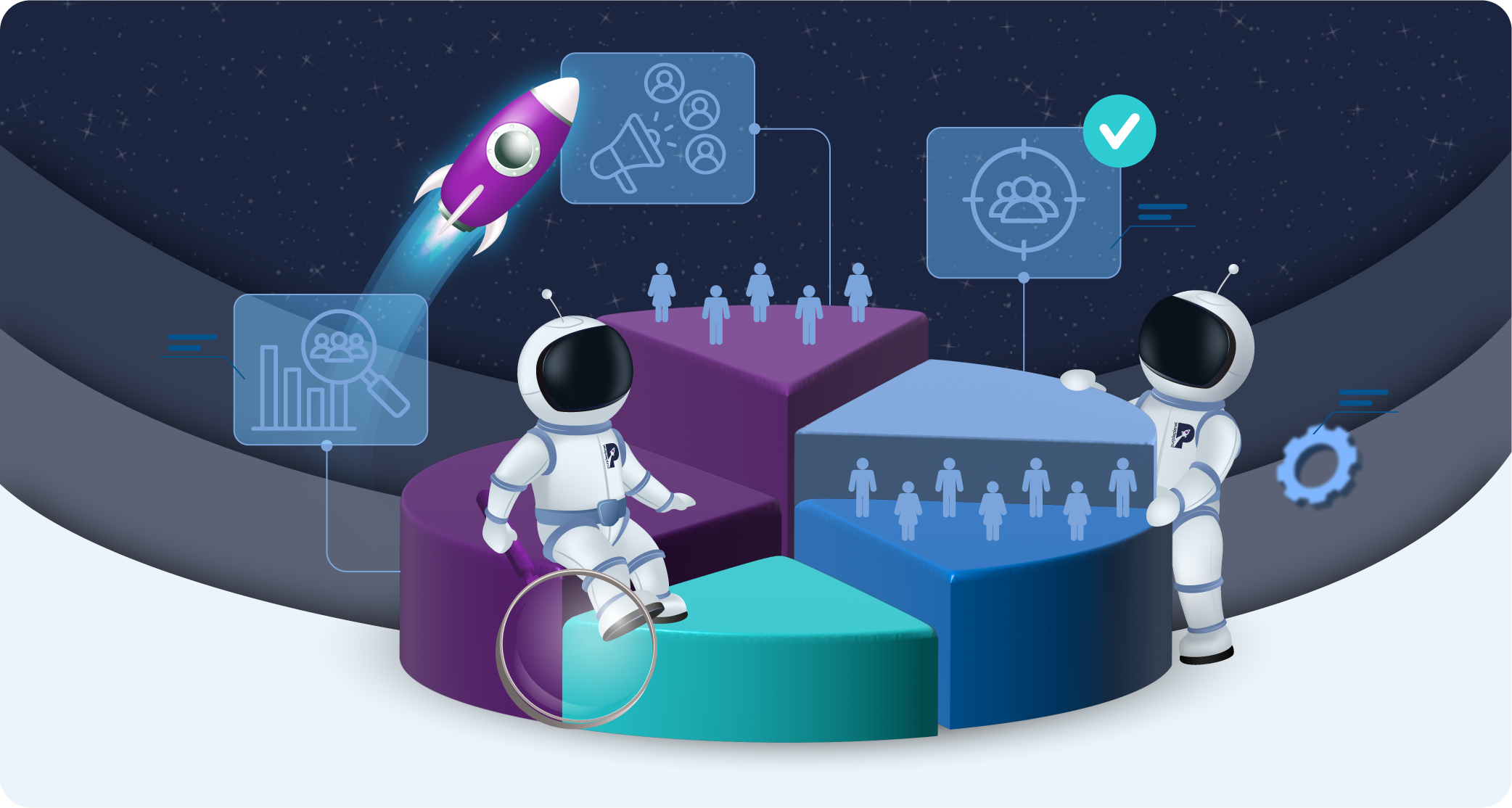

Utilising Lookalike Audiences: 5 Strategies for Expanding Reach
In 2013, Facebook created Lookalike Audiences, a feature that allows advertisers to reach new potential customers because they are similar to their existing customers (whether demographically or in their online behaviour).
Lookalike Audiences is highly popular among businesses using Facebook for advertising as they can leverage Facebook’s vast amount of user data to create targeted ad campaigns. More importantly, though, these campaigns are designed to reach those who are most likely to be converted.
Consequently, businesses benefit from increased conversions but also a higher ROI because their ad spend is much more efficient. Using Lookalike Audiences enables businesses of all sizes to expand their reach, improve customer acquisition, and stand out against the competition.
The tool’s versatility means businesses can attain the above benefits in several ways. This blog will explore five of them, providing a variety of approaches and best practices to elevate your campaigns.
Why expand reach?
It’s right to be wary about expanding reach indiscriminately because there’s a risk of wasting ad spend. Broadening your audience too much means you might be targeting individuals who won’t be interested in your offering, therefore increasing costs without guaranteed returns.
Despite this valid concern, expanding reach can be done ‘correctly’ and help with both business growth and brand awareness. A tool like Lookalike Audiences allows businesses to expand their reach with specificity – to people who are more likely to convert.
Expanding reach can also provide valuable data and insights into new market segments, helping businesses refine their strategies and better understand consumer behaviour. This can lead to more effective future campaigns, so it’s worth trying.
The five strategies we’ll discuss today are fairly straightforward. Once you’ve created one Lookalike Audience, you’ll easily be able to do another. The process doesn’t differ much between the five approaches, only varying at the beginning when you’re inputting data.
For this reason, Lookalike Audiences are one of those approaches where the payoff is much more than the initial planning and execution!
Let’s dive in.
5 Lookalike Audience strategies to expand reach
Lookalike Audiences are created by taking an existing Custom Audience and finding new users on Facebook who share similar characteristics and behaviours. There are lots of ways to get creative with this feature, but we’ll explore five main approaches…
1. Target high-value customers
This approach asks you to leverage data from your top customers, such as lifetime value, purchase frequency, and engagement metrics, to create a new audience segment that mirrors these high-value traits.
High-value customers typically have a higher lifetime value, making them more profitable over time. By targeting new users with similar behaviours and demographics, you increase the likelihood of attracting customers who will also demonstrate high loyalty and spending power. This approach not only improves your return on investment but also enhances customer loyalty and retention.
To implement this strategy, start by identifying your high-value customers using your customer relationship management (CRM) system or analytics tools like Google Analytics and Facebook Insights. Gather data on key metrics such as lifetime value, purchase frequency, and engagement levels.
The following instructions will apply to each of the five strategies in this blog:
(Once you have this data, create a Custom Audience in Facebook Ads Manager by uploading your customer list or using data from your website or app via the Meta Pixel code. Next, generate a Lookalike Audience by selecting your Custom Audience as the source. Choose the target country and adjust the audience size, keeping in mind that smaller percentages yield audiences more similar to your source, while larger percentages increase reach but reduce similarity. Finally, launch your ad campaigns targeting this new Lookalike Audience and monitor performance closely to make necessary adjustments.)
Be aware that the accuracy and timeliness of the data you use is crucial. If it’s outdated or inaccurate, your targeting could be poor and ineffective. There’s also the risk of audience overlap, which can cause ad fatigue (and be expensive for you!).
To elevate your strategy to the next level, you could combine your targeting criteria of high-value customers with another relevant demographic. You might also like to experiment with different audience sizes to find the optimal balance between reach and similarity.
2. Expand video viewers
Given the huge popularity of video content online, focusing on video viewers is full of potential. People are picky about video content, making video engagement metrics full of rich insights. Using these insights, you can target potential customers with similar video interests and behaviours to already paying customers, reaching users most likely to engage with your content.
Often, videos can convey messages more effectively than static images and text. This engaging format is also more sharable which, if viewers do, can amplify your reach even further, organically.
To implement this strategy, you’re going to follow a similar process as before, but the beginning stage will be different. Start by identifying users who have engaged with your video content. This could include those who have watched a certain percentage of your videos, liked, commented, or shared them.
Things to bear in mind for video marketing:
- Producing high-quality visuals and compelling stories could require substantial resources.
- Not all viewers who watch a video will convert into customers, so, balance the investment into video production with the potential returns.
- Focus on creating high-quality, engaging video content that resonates with your target audience.
- Experiment with different video formats, such as live videos, tutorials, or behind-the-scenes content, to see what resonates best with your audience.
- Use A/B testing to refine your video ads and improve their performance.
- Avoid creating overly long or unengaging videos, as this can lead to high drop-off rates and waste money.
- Ensure that your videos have a clear call to action and are aligned with your overall marketing goals.
If you choose to take the video targeting route, remember that it will have to be backed up with a solid video content creation strategy. Therefore, this option may not be so attractive to businesses with small or cheaply-ran video strategies.
3. Utilise app activity
Users who are already active within your app have demonstrated a clear interest and willingness to engage with your content or services. By creating a Lookalike Audience based on these engaged users, you can find new potential users who are likely to have similar interests and behaviours.
This approach involves using data from users who frequently engage with your app or complete significant actions within it, such as making in-app purchases or logging in frequently.
Targeting new users who exhibit similar behaviours will help you attract individuals likely to download, use, and spend money within your app, thus expanding your reach and boosting app engagement.
As with the other approaches, targeting these high-value users can lead to a more efficient use of your advertising budget, as you are focusing on individuals more likely to convert.
To implement this strategy, you need to gather data from your app users. This involves tracking key metrics such as frequency of use, duration of sessions, and in-app purchases.
To target users based on in-app activity from non-Facebook apps, you’ll need to integrate Facebook SDK into your app. The SDK allows you to track specific events within your app, such as app installs, in-app purchases, and user engagement metrics. This data is then sent to Facebook, where it can be used to create Custom Audiences.
As above, it’s crucial that the data you use is recent and complete – you could update your Lookalike Audience regularly with the latest app activity data to ensure this. And of course, like with any in-app advertising strategy, experiment with different ad formats to see which is most engaging to users.
4. Leverage website traffic
Website traffic is another source of valuable data.
This means using data about site visitors who have shown interest in your products or services or engaged with your site in a meaningful way (e.g., added items to their carts or spent significant time on key pages) to find new users who are likely to engage with your ads.
This approach makes for a very efficient use of your advertising budget as you’re focusing on users who are more likely to convert – website visitors who engage deeply with your site are already demonstrating considerable interest in your offerings, making Lookalike Audiences very valuable.
To implement this strategy, begin by gathering data on your website visitors. Utilise tools like Google Analytics or Facebook Pixel to track key metrics such as page views, session duration, and actions taken on your site and follow the steps discussed above.
With this strategy, it’s important that your website provides a seamless user experience so that engagement and positive interactions continue to be encouraged. And similarly, as before, you’ll want to avoid using overly broad audiences, update your Lookalike Audience regularly, experiment with different sizes, and try out different ad formats.
5. Engage with active email subscribers
Engaged email subscribers are a goldmine of potential customers, and targeting users with similar engagement patterns can significantly boost campaign performance. This strategy helps in building a community of loyal customers who are receptive to your brand’s messaging and promotions.
To implement this strategy, start by identifying your most engaged email subscribers. This can be done by analysing metrics such as open rates, click-through rates, and frequency of interactions. As before, create your Lookalike Audience with this data.
Don’t forget that privacy concerns and compliance with data protection regulations are crucial, as mishandling subscriber data can lead to legal issues and loss of trust.
In addition, don’t forsake the usual email best practices when steaming ahead with your new strategy. It’s still important that you don’t over-target or spam users with your efforts, as they may disengage due to ad fatigue. You might like to combine your efforts with an email design makeover, ensuring it’s as engaging as possible. Following email best practices will ensure your Lookalike Audience efforts pack as much of a punch as possible.
Final thoughts
By focusing on individuals who share characteristics with your most valuable or engaged customers, you can increase the effectiveness of your ad spend and drive more meaningful engagement.
The tip we’ll leave you with is to avoid relying solely on one Lookalike Audience. Diversifying your targeting strategies ensures a broader reach and reduces the risk of over-dependence on a single audience segment.
To get help with your targeting efforts, reach out to us here at purpleplanet.











